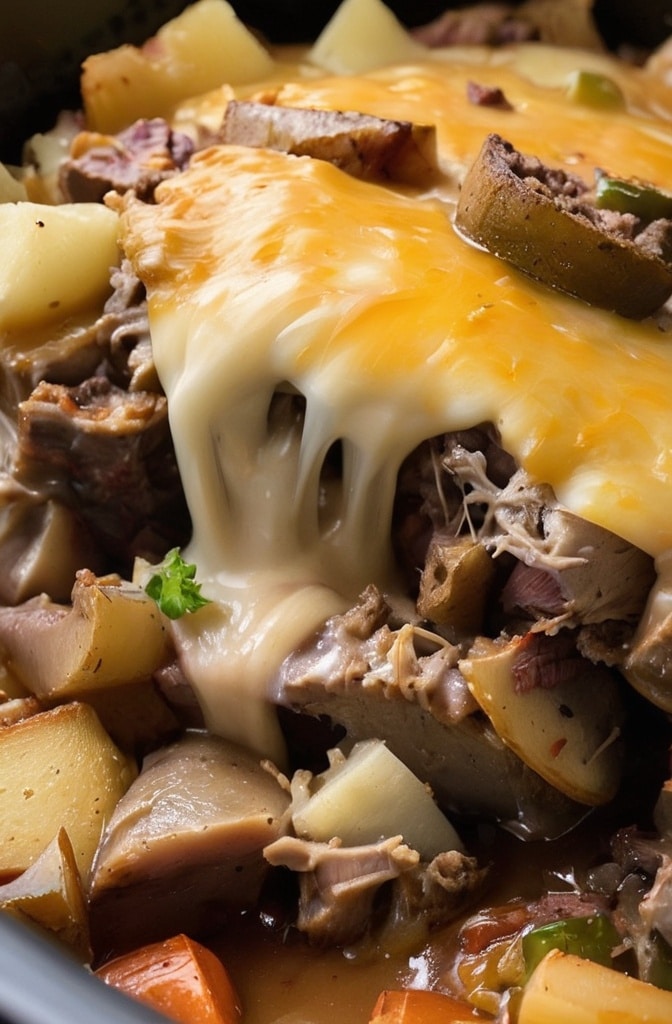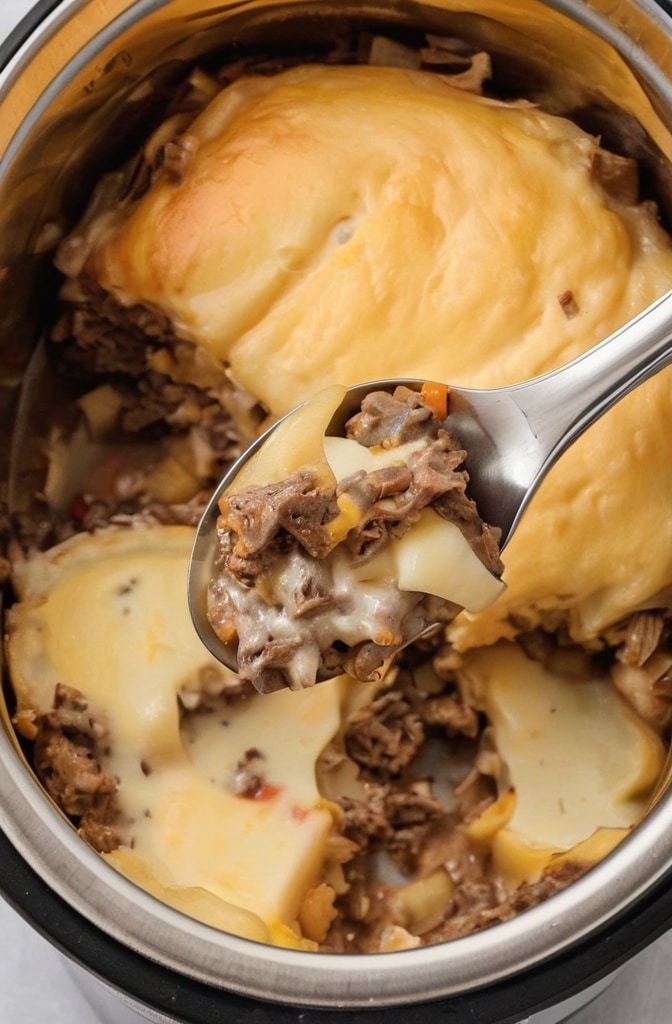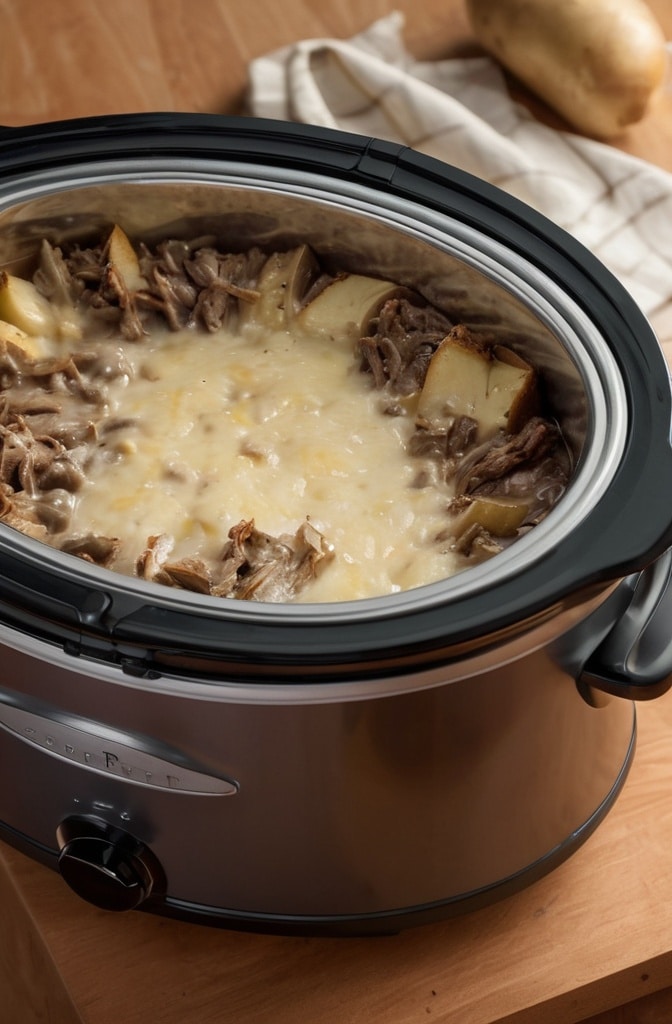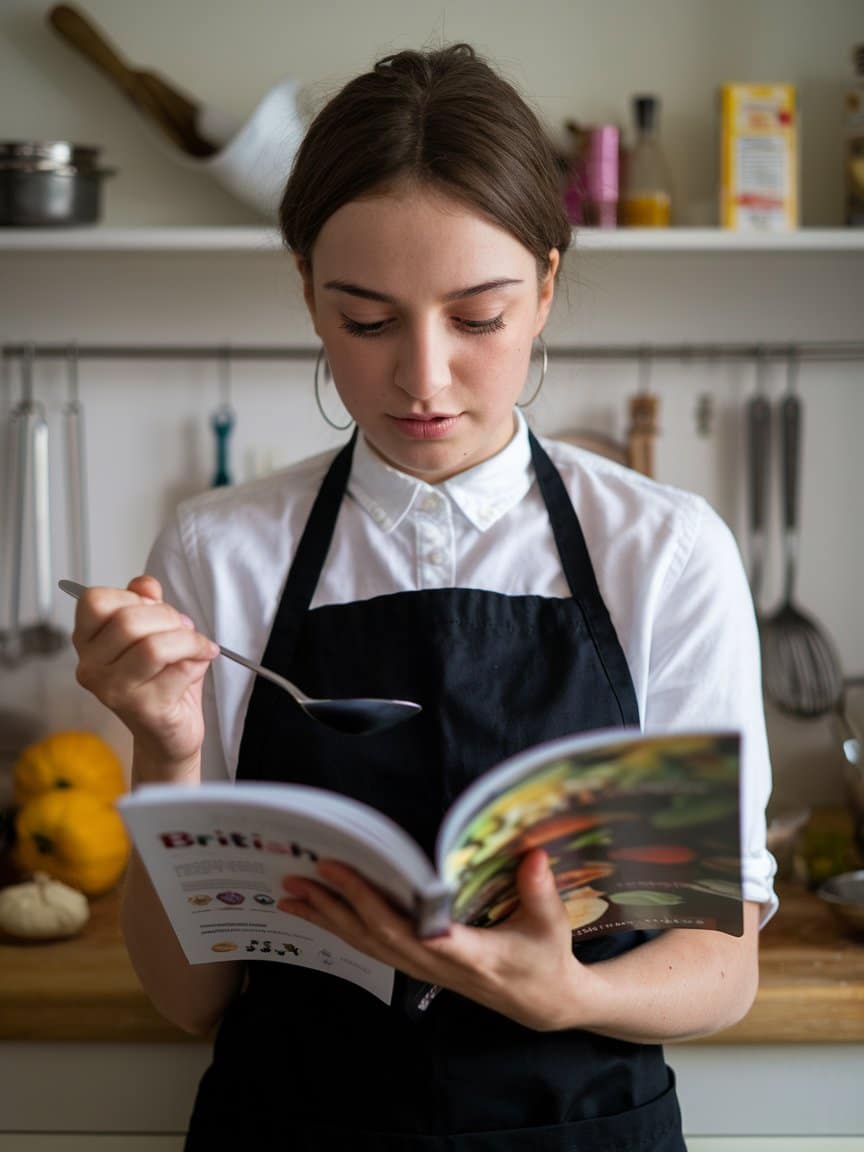The Ultimate Comfort Food Revolution
I still remember the first time I brought my Crockpot Cheesesteak Potato Casserole to a neighborhood potluck. The dish was scraped clean within minutes, and three people cornered me by the dessert table demanding the recipe. There’s somethin’ magical about the marriage of tender beef, caramelized onions, melted cheese, and hearty potatoes that transforms a slow cooker into a miracle worker. This isn’t just another casserole—it’s comfort food alchemy at its finest.

What makes this dish truly special is how it brilliantly fuses two beloved American classics—Philly cheesesteaks and loaded potato casseroles—into one fuss-free, set-it-and-forget-it masterpiece. The slow cooking process allows the flavors to develop and meld in ways that stovetop or oven preparation simply cannot achieve. It’s the perfect solution for busy weeknights, weekend gatherings, or anytime you crave something deeply satisfying without hours of active kitchen time.
Ingredients & Substitutions
For the Base:
- 2½ pounds russet potatoes (about 5-6 medium potatoes), sliced ¼-inch thick
- 1½ pounds thinly sliced ribeye steak (can substitute sirloin or top round)
- 2 large bell peppers (1 green, 1 red), thinly sliced
- 2 large yellow onions, thinly sliced
- 4 cloves garlic, minced
- 3 tablespoons olive oil, divided
- 2 tablespoons Worcestershire sauce
- 1 tablespoon beef better than bouillon (or 2 beef bouillon cubes)
- ½ cup beef broth
- 1 teaspoon dried oregano
- 1 teaspoon dried thyme
- 1 teaspoon smoked paprika
- ½ teaspoon freshly ground black pepper
- Salt to taste
For the Cheese Layer:
- 8 ounces provolone cheese, sliced or shredded
- 8 ounces white American cheese, sliced or shredded
- 4 ounces mozzarella cheese, shredded
Optional Garnishes:
- 3 tablespoons fresh parsley, chopped
- Sliced green onions
- Hot sauce or banana peppers

The quality of your beef makes all the diffrence in this recipe. While traditional Philly cheesesteaks call for ribeye, budget-friendly options like sirloin or top round work beautifully when slow-cooked. For those avoiding red meat, thinly sliced chicken breast or portobello mushrooms offer excellent alternatives with shorter cooking times (about 3-4 hours on low).
For potato substitutions, Yukon Golds provide a creamier texture, while red potatoes hold their shape better. Sweet potatoes can introduce an interesting flavor contrast but require about 30 minutes less cooking time to prevent mushiness.
Cheese selection is crucial for authentic flavor. If provolone isn’t available, Swiss cheese provides similar nuttiness. Authentic Philly cheesesteaks often use Cheez Whiz, which you can certainly incorporate for nostalgic authenticity. For dairy-sensitive eaters, nutritional yeast mixed with cashew cream provides surprising cheesy notes.
Step-by-Step Instructions
Preparation Phase:
- Slice potatoes to an even ¼-inch thickness—any thinner and they’ll disintegrate, any thicker and they won’t cook through properly. A mandoline slicer is invaluable here for consistency, but a sharp chef’s knife works too. Pro tip: Soak sliced potatoes in cold water for 20 minutes, then pat dry to remove excess starch for better texture.
- Partially freeze the beef (about 20-30 minutes in freezer) before slicing to achieve paper-thin cuts that will cook evenly and remain tender. Cut against the grain for maximum tenderness. Common mistake: Many home cooks slice their beef too thick, resulting in chewy meat that doesn’t properly integrate with the other ingredients.
- Properly caramelize your onions and peppers before adding to the crockpot. Heat 2 tablespoons olive oil in a large skillet over medium-low heat, add onions with a pinch of salt and cook slowly, stirring occasionally, until golden brown (about 15-20 minutes). Add peppers during the last 5 minutes. This develops foundational flavors that cant be achieved in the slow cooker alone.
Assembly and Cooking:
- Grease your slow cooker insert thoroughly with cooking spray or butter. Layer half the potato slices on the bottom, slightly overlapping them. Season with salt, pepper, half the dried herbs, and half the minced garlic. This layering technique ensures even flavor distribution throughout the casserole.
- In a large bowl, toss the sliced beef with remaining olive oil, Worcestershire sauce, remaining herbs, and spices. Layer half the seasoned beef over the potatoes, followed by half the caramelized onions and peppers. For depth of flavor, I sometimes add a splash of good quality stout beer to the beef mixture—the alcohol cooks off completely while leaving behind complex malty notes.
- Create a second identical layer with remaining potatoes, beef, and vegetables. Pour beef broth mixed with better than bouillon over everything. The liquid should come up about ¼ inch from the bottom—not enough to make it soupy, but sufficient to create steam for proper cooking and prevent burning. Cook on low for 6-7 hours or high for 3-4 hours, until potatoes are fork-tender.
- During the final 30 minutes of cooking, layer the cheeses on top in this order: American cheese first (it melts most smoothly), followed by provolone, and finally mozzarella. Cover and continue cooking until cheese is completely melted and slightly bubbly. Resist the urge to peek frequently during cooking—each time you lift the lid, you’re adding 15-20 minutes to the required cooking time.
Finishing Touches:
- Once cooked, let the casserole rest uncovered for 15 minutes before serving. This crucial step allows the layers to set and prevents a runny consistency. For a crisper top, some chefs transfer the crockpot insert (if oven-safe) under the broiler for 2-3 minutes to create a golden, bubbly cheese crust.
- Garnish with freshly chopped parsley and green onions just before serving. These bright elements balance the richness of the dish and add visual appeal. For heat lovers, a sprinkle of crushed red pepper flakes or sliced banana peppers adds pleasant zip.
- For serving at gatherings, keep the crockpot on the “warm” setting, but add a tablespoon of beef broth every hour to prevent the edges from drying out. A clever variation: serve in hollowed-out crusty bread bowls for an impressive presentation that pays homage to the sandwich origins of cheesesteaks.
Cooking Techniques & Science
The magic of this casserole lies in several key techniques that maximize flavor development. First, there’s the Maillard reaction—that beautiful browning that occurs when proteins and sugars in the beef and onions are heated together. Pre-caramelizing these ingredients before slow cooking creates complex flavor compounds that simply wouldn’t develop at the lower temperatures of a crockpot alone.

The layering method serves both practical and culinary purposes. From a scientific standpoint, it allows for even heat distribution throughout the dish, ensuring consistent cooking. Culinarily, it creates distinct flavor zones that meld together as they cook, rather than producing a one-note mixture. The potatoes on the bottom serve as insulation against the direct heat source, preventing burning while absorbing savory drippings from the layers above.
Understanding moisture control is critical in slow cooking. Too much liquid creates a soupy mess; too little results in burnt edges and undercooked centers. The small amount of beef broth combined with natural juices released from the meat and vegetables creates the perfect humid environment inside the sealed crockpot. This gentle steam-cooking environment breaks down tough collagen in cheaper cuts of beef, transforming them into tender morsels indistinguishable from pricier cuts.
The role of your slow cooker’s settings shouldn’t be overlooked. The “low” setting hovers around 190°F (88°C), perfect for the low-and-slow approach that develops flavor without toughening proteins. The “high” setting reaches about 300°F (149°C), which can be used to expedite cooking but requires closer monitoring to prevent overcooking. Modern programmable slow cookers with temperature probes take the guesswork out of achieving perfect results.
Cheese application involves careful timing and layering. Adding cheese too early results in separation and an oily layer; too late and it won’t properly integrate with the dish. The 30-minute window before completion allows the cheese proteins to relax and melt while retaining their creamy texture. The combination of different cheeses isn’t just for flavor—it’s a textural strategy. American cheese contains sodium citrate, which acts as an emulsifier, helping the other cheeses melt smoothly rather than separating into greasy pools.
Serving & Pairing Suggestions
This hearty casserole deserves thoughtful presentation and complementary pairings. For family-style serving, transfer to a pre-warmed stoneware dish and garnish with vibrant elements like sliced cherry tomatoes, fresh herbs, and perhaps a light drizzle of hot sauce for color contrast. Individual portions benefit from being served in wide, shallow bowls that showcase the beautiful layers.

The robust flavors pair exceptionally well with bright, acidic sides that cut through the richness. Consider a simple arugula salad dressed with lemon vinaigrette, pickled vegetables, or a crisp slaw with apple cider vinegar dressing. For bread service, nothing beats garlic butter texas toast or soft pretzel rolls that pay homage to Philadelphia street food traditions.
Beverage pairings depend on the occasion. For casual family dinners, a malty amber ale or hoppy IPA stands up beautifully to the savory elements. Wine enthusiasts should reach for medium-bodied reds with good acidity—think Sangiovese or Zinfandel. Non-alcoholic options include sparkling water with lemon or a tart cherry-cranberry spritzer that refreshes the palate between rich bites.
Make-ahead potential is another strength of this dish. You can assemble everything except the cheese layer up to 24 hours in advance, refrigerate, and then slow cook the next day. Alternatively, cook completely, refrigerate, and reheat portions in a 325°F oven until the center reaches 165°F. The flavors actually improve after a day, as the ingredients have more time to meld together.
Leftovers transform brilliantly into next-day creations. Try stuffing the casserole into bell peppers and baking until tender, rolling it into flour tortillas for fusion quesadillas, or folding it into an epic omelet with additional provolone cheese. Morning-after hash with a fried egg on top has converted many breakfast skeptics in my household.
Conclusion
Crockpot Cheesesteak Potato Casserole represents the best of American comfort food innovation—taking beloved flavors and reimagining them in a format that’s both convenient and deeply satisfying. The beauty of this dish lies not just in its indulgent flavors, but in its adaptability to different dietary needs, budget considerations, and serving occasions.
What I’ve learned through countless iterations of this recipe is that patience truly pays dividends. Don’t rush the caramelization of your onions and peppers—those 20 minutes create foundational flavors that will define your finished dish. Similarly, the slow cooking process isn’t just about convenience; it’s an essential technique for developing the melded flavors that make this casserole so much more than the sum of its parts.
Remember that the best cooking comes from understanding techniques rather than rigidly following recipes. Once you’ve mastered the basic method, don’t be afraid to make this dish your own. Maybe you’ll add mushrooms for umami depth, incorporate poblano peppers for smoky heat, or experiment with different regional cheese combinations. Whatever direction you take it, this crockpot wonder deserves a permanent place in your comfort food repertoire.
Frequently Asked Question?
Can I prepare this casserole the night before and cook it the next day?
Absolutely! You can assemble the entire dish (except for the cheese) and refrigerate overnight. Add about 30 minutes to your cooking time if starting with cold ingredients straight from the fridge. Just remember to keep the potatoes submerged in the liquid mixture to prevent browning.
My casserole turned out watery—what went wrong?
This typically happens when the potatoes release too much moisture during cooking. Try soaking sliced potatoes in cold water for 20 minutes, then patting them completely dry before assembling. Also, avoid opening the lid during cooking, as condensation will drip back into your dish, increasing liquid content.
Can I make this in an Instant Pot or oven instead?
Yes to both! For Instant Pot, use the sauté function to brown the meat and vegetables first, then layer ingredients as directed. Cook on high pressure for 12 minutes with a 10-minute natural release. For oven preparation, assemble in a greased 9×13 baking dish, cover tightly with foil, and bake at 350°F for about 90 minutes, adding cheese during the final 15 minutes.
Is there a way to make the top crispy like a traditional casserole?
If your slow cooker has an oven-safe insert, you can place it under the broiler for 2-3 minutes after cooking is complete. Alternatively, transfer portions to individual oven-safe ramekins, top with additional cheese or buttered breadcrumbs, and broil until golden and bubbling.
How can I adapt this for a vegetarian version that still has the “meaty” texture?
Portobello mushrooms sliced ¼-inch thick make an excellent beef substitute when marinated in soy sauce, liquid smoke, and Worcestershire sauce (vegetarian versions exist). Seitan or tempeh also work well when sliced thinly and pre-seared. Reduce cooking time to 4-5 hours on low, as plant proteins don’t require as much time to tenderize as beef.

Veronica is a passionate food enthusiast with over three years of experience in exploring and writing about diverse cuisines. Her expertise lies in reviewing restaurants, sharing creative recipes, and discovering the latest food trends. As the voice behind FoodieRecap.com, Anju brings fresh perspectives and culinary insights to her audience.
